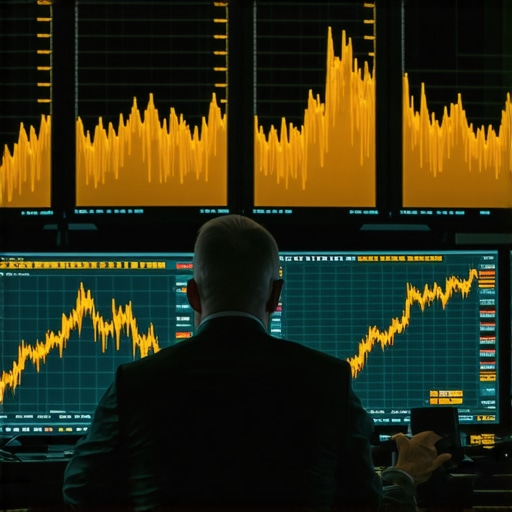Introduction to Gold Futures Trading
Gold futures trading represents a crucial aspect of the commodities market, attracting both seasoned investors and newcomers alike. This financial instrument allows traders to buy and sell contracts for future delivery of gold at a predetermined price. Understanding the complexities of gold futures trading can help investors make informed decisions, navigate market volatility, and capitalize on price movements.
The Mechanics of Gold Futures Contracts
At its core, a gold futures contract is an agreement to buy or sell a specific amount of gold at a future date, typically measured in troy ounces. The standard contract size for gold futures is 100 ounces, making it essential for traders to understand how contract specifications, expiration dates, and settlement processes work. Traders can either take delivery of the physical gold or settle their contracts in cash, depending on their investment strategy.
Key Elements of Gold Futures Trading
Several key elements influence gold futures trading:
- Market Conditions: Economic indicators, geopolitical events, and changes in supply and demand significantly impact gold prices. For instance, during times of economic uncertainty, gold often serves as a safe haven, driving prices higher.
- Leverage: Futures trading typically involves leverage, allowing traders to control large positions with a relatively small amount of capital. While leverage can amplify profits, it also increases the potential for significant losses.
- Margin Requirements: Traders must maintain a minimum margin balance in their accounts, which acts as collateral for their positions. Understanding margin requirements is crucial to avoid margin calls and potential liquidation of positions.
Benefits and Risks of Trading Gold Futures
Investing in gold futures offers several advantages, including the potential for high returns and the ability to hedge against inflation and currency fluctuations. However, it’s essential to recognize the risks involved. Market volatility can lead to rapid price fluctuations, and the use of leverage can amplify losses. Therefore, a well-thought-out trading strategy and risk management practices are vital for success in gold futures trading.
Strategies for Successful Gold Futures Trading
To navigate the complexities of gold futures trading effectively, investors can consider various strategies:
- Technical Analysis: Analyzing price charts and market trends can help traders identify potential entry and exit points. Utilizing indicators like moving averages and RSI can provide insights into market momentum.
- Fundamental Analysis: Understanding the broader economic landscape, including central bank policies and global economic indicators, can inform trading decisions. For instance, shifts in interest rates or inflation expectations can significantly influence gold prices.
- Diversification: Incorporating gold futures into a diversified portfolio can help manage risk. By balancing gold investments with other asset classes, traders can mitigate potential losses during market downturns.
In conclusion, understanding the complexities of gold futures trading is essential for making informed investment decisions. By grasping the mechanics of futures contracts, recognizing the benefits and risks, and implementing effective trading strategies, investors can navigate this dynamic market successfully. For more insights into gold investment strategies, consider exploring our guides on maximizing investment in gold coins and investing in gold mutual funds to enhance your trading knowledge.
Advanced Strategies for Gold Futures Trading
To gain an edge in the competitive arena of gold futures trading, investors can adopt advanced strategies tailored to the unique characteristics of the gold market. These strategies not only enhance the potential for profit but also contribute to more effective risk management.
Utilizing Options in Gold Futures
Incorporating options into gold futures trading can provide investors with additional flexibility and strategies for risk management. Options allow traders to speculate on future price movements without the obligation to buy or sell the underlying asset. For example, buying call options can be a strategic move if you anticipate rising gold prices, while put options can serve as a hedge against potential downturns.
Position Sizing and Risk Management
Effective position sizing is crucial for managing risk in gold futures trading. By determining the appropriate amount of capital to allocate to each trade, investors can limit their exposure to market volatility. A common guideline is to risk no more than 1-2% of your trading capital on a single trade. This approach helps safeguard your portfolio against significant losses while allowing for the potential to capitalize on profitable trades.
Market Analysis Techniques for Gold Futures
Understanding market trends and dynamics is essential for successful gold futures trading. Investors can leverage various analysis techniques to make informed decisions.
Sentiment Analysis
Market sentiment can greatly influence gold prices, making sentiment analysis a vital tool for traders. By monitoring news, social media, and market reports, investors can gauge public perception and potential price movements. For instance, a surge in negative news surrounding economic instability may boost gold demand as a safe haven asset, driving prices higher.
Correlation with Other Markets
Gold often exhibits correlations with other financial markets, such as equities and currencies. Understanding these correlations can provide valuable insights into potential price movements. For example, when stock markets decline, gold prices may rise as investors seek refuge in tangible assets. Monitoring these correlations can enhance trading strategies and timing.
Exploring the Future of Gold Futures Trading
The landscape of gold futures trading is continuously evolving, influenced by technological advancements and changing market dynamics. As digital trading platforms gain popularity, accessibility for retail investors has increased, allowing more individuals to participate in gold futures trading.
Technological Impact on Trading
With the rise of algorithmic trading and artificial intelligence, traders can analyze vast amounts of data quickly, identifying trends and executing trades with precision. Utilizing these technologies can enhance trading efficiency and profitability. Additionally, mobile trading apps enable investors to monitor market conditions and make informed decisions on-the-go, further democratizing access to gold futures trading.
Conclusion
In conclusion, navigating the world of gold futures trading requires a combination of knowledge, strategy, and adaptability. By employing advanced trading strategies, understanding market analysis techniques, and embracing technological advancements, investors can position themselves for success in this dynamic market. For those looking to deepen their understanding of gold investments, consider exploring our guides on gold price trends and the risks and rewards of gold mining stocks for further insights into maximizing your investment potential.
Leveraging Technical Analysis in Gold Futures
Technical analysis plays a pivotal role in gold futures trading, enabling traders to make data-driven decisions based on historical price movements and patterns. By utilizing various indicators, traders can identify trends and potential reversal points in the market. Popular tools include moving averages, Relative Strength Index (RSI), and Fibonacci retracement levels. These indicators help in assessing the market sentiment and determining optimal entry and exit points for trades.
Understanding Price Patterns
Recognizing price patterns is essential for predicting future movements in gold futures. Patterns such as head and shoulders, triangles, and flags can signal potential price actions. For instance, a head and shoulders pattern may indicate a market reversal, signaling traders to take protective measures or capitalize on the anticipated price decline.
Volume Analysis
Volume is another crucial aspect of technical analysis. Analyzing trading volume can provide insights into the strength of a price movement. A price increase accompanied by high volume typically indicates strong momentum, whereas a price increase with low volume may suggest a lack of conviction. Understanding these dynamics allows traders to make informed decisions about their positions in gold futures.
Utilizing Fundamental Analysis for Gold Trading
While technical analysis focuses on historical price data, fundamental analysis examines economic indicators that influence gold prices. Key factors include inflation rates, interest rates, and geopolitical events. For instance, rising inflation often leads to increased gold demand as investors seek a hedge against currency devaluation.
The Role of Central Banks
Central banks play a significant role in shaping the gold market. Their policies regarding gold reserves and purchases can significantly impact prices. Monitoring central bank activities, such as gold buying or selling, can provide valuable insights into market trends. For example, if a central bank announces an increase in gold purchases, it may signal future price increases, prompting traders to adjust their strategies accordingly.
Geopolitical Factors and Their Influence on Gold Prices
Geopolitical tensions often drive investors toward gold, viewing it as a safe haven during uncertain times. Events such as trade wars, military conflicts, and political instability can lead to increased gold demand, subsequently influencing prices. Staying informed about global events and their potential impact on the gold market is essential for traders aiming to capitalize on these shifts.
Effective Risk Management Techniques for Gold Futures
Implementing robust risk management strategies is crucial for success in gold futures trading. Effective risk management helps protect capital and minimizes potential losses. One of the primary techniques is setting stop-loss orders, which automatically close positions at predetermined price levels, thereby limiting losses.
Diversification in Gold Investments
Diversifying investments within the gold market can also enhance risk management. Traders may consider diversifying their portfolios by investing in different gold-related assets, such as gold ETFs, mining stocks, or physical gold. This approach mitigates the risk associated with a single investment and can provide a more stable return over time.
Continuous Education and Adaptation
The gold market is continuously evolving, making ongoing education and adaptation essential for traders. Staying updated on market trends, economic indicators, and trading strategies can provide a competitive edge. Engaging in trading communities, attending webinars, and reading relevant literature can help traders refine their skills and strategies.
In summary, effective gold futures trading requires a multifaceted approach, incorporating technical and fundamental analysis, alongside robust risk management practices. By employing these advanced strategies, traders can enhance their ability to navigate the complexities of the gold market. For more insights into gold investments, explore our comprehensive guide on investing in gold ETFs and strategies to maximize returns.
Exploring Advanced Trading Strategies for Gold Futures
To thrive in the volatile landscape of gold futures, traders must embrace advanced trading strategies that leverage both technical and fundamental insights. This multifaceted approach enables traders to capitalize on market fluctuations effectively.
Understanding the Impact of Economic Indicators
Economic indicators are fundamental to predicting gold price movements. Key indicators such as GDP growth rates, employment statistics, and consumer confidence surveys can significantly influence market sentiment. For example, a downturn in economic growth may lead to a surge in gold demand as investors seek a safe haven. Monitoring these indicators allows traders to align their strategies with market expectations, enhancing their potential for profitable trades.
Utilizing Chart Patterns for Predictive Insights
Chart patterns provide valuable insights into potential future movements in gold futures. Patterns like double tops, double bottoms, and ascending triangles can indicate market sentiment shifts. A double bottom pattern, for instance, often signifies a bullish reversal, suggesting that traders should consider entering long positions. By mastering these patterns, traders can develop a keen sense of market dynamics and make informed decisions.
Implementing Trading Algorithms for Gold Futures
Algorithmic trading is increasingly popular in the gold futures market, allowing traders to execute strategies based on predefined criteria. Algorithms can analyze vast amounts of data quickly, identifying trading opportunities that might be missed by manual analysis. Integrating algorithms into your trading strategy can enhance efficiency and reduce emotional decision-making.
Backtesting Trading Strategies
Before implementing a trading algorithm, it is crucial to backtest the strategy against historical data. Backtesting allows traders to evaluate the effectiveness of their algorithms, ensuring they are well-suited to current market conditions. This process can help identify potential weaknesses and refine strategies before real capital is at risk.
Staying Updated with Market News and Trends
In the fast-paced world of gold trading, staying informed about market news is vital. Economic reports, central bank announcements, and geopolitical developments can all impact gold prices. Subscribing to financial news services or using market analysis tools can provide traders with timely information, enabling them to react quickly to market changes. For instance, an unexpected change in interest rates can lead to immediate price fluctuations, making it essential for traders to be prepared.
Maintaining a Comprehensive Trading Journal
A trading journal is an invaluable tool for any trader, especially in the gold futures market. Documenting trades, strategies, and market observations helps traders identify patterns in their performance. This practice allows for continuous improvement as traders analyze what works and what doesn’t over time. A well-maintained journal can serve as a roadmap to refining trading strategies and enhancing overall performance.
Conclusion: Strategies for Success in Gold Futures
Success in gold futures trading hinges on the ability to combine advanced strategies, market awareness, and disciplined risk management. By applying economic indicators, mastering chart patterns, utilizing algorithms, and maintaining a trading journal, traders can position themselves for success in this dynamic market. For further insights into optimizing your gold investments, consider exploring our detailed guide on gold price forecasts and strategies to enhance your trading performance.
Frequently Asked Questions about Gold Futures Trading
1. What are gold futures and how do they work?
Gold futures are contracts that obligate the buyer to purchase, and the seller to sell, a specific amount of gold at a predetermined price on a specified future date. They are traded on commodities exchanges and are used by investors to hedge against price fluctuations or to speculate on the future price of gold.
2. What factors influence the price of gold?
The price of gold is influenced by several factors, including economic indicators, inflation rates, interest rates, and geopolitical events. Supply and demand dynamics, as well as market sentiment, also play crucial roles in determining gold prices.
3. How can I start trading gold futures?
To start trading gold futures, you need to open a brokerage account that allows futures trading. After funding your account, you can analyze market trends and economic indicators to develop a trading strategy focused on gold futures.
4. What are the risks associated with gold futures trading?
Gold futures trading involves significant risks, including market volatility, leverage effects, and the potential for substantial financial loss. It’s essential for traders to employ risk management strategies, such as setting stop-loss orders and diversifying their portfolios.
5. How do I use technical analysis in gold futures trading?
Technical analysis in gold futures trading involves studying price charts, patterns, and indicators to predict future price movements. Traders often use tools like moving averages, Relative Strength Index (RSI), and Bollinger Bands to make informed decisions.
6. Can I trade gold futures with a small investment?
Yes, many brokers offer mini or micro futures contracts, allowing traders to enter the gold futures market with a smaller investment. However, it’s crucial to understand the risks and potential for losses associated with trading on margin.
7. What is the importance of a trading plan in gold futures?
A trading plan is essential for success in gold futures trading as it outlines your trading goals, strategies, risk management techniques, and evaluation methods. A well-defined plan helps maintain discipline and consistency in your trading approach.
8. How can I stay updated on gold market news?
Staying updated on gold market news can be achieved by subscribing to financial news websites, following market analysts on social media, and utilizing economic calendars that highlight upcoming reports affecting gold prices.
9. What are some common mistakes to avoid in gold futures trading?
Common mistakes in gold futures trading include over-leveraging, neglecting risk management, failing to adapt to changing market conditions, and allowing emotions to drive trading decisions. Maintaining discipline and a clear strategy can help mitigate these mistakes.
10. Is it better to trade gold futures or physical gold?
Whether to trade gold futures or invest in physical gold depends on your investment goals. Gold futures offer leverage and the potential for profit without needing to store physical gold, while physical gold can serve as a tangible asset for long-term security and wealth preservation.
Authority Resources for Gold Futures Trading
For those looking to deepen their knowledge of gold futures trading, several trusted resources can provide expert insights and data:
- CME Group – Gold Futures Education: Comprehensive educational materials on gold futures and trading strategies.
- Investing.com – Gold Futures Analysis: Real-time data, analysis, and news on gold futures.
- Kitco – Precious Metals News: A trusted source for news, analysis, and prices related to gold and other precious metals.
- Bloomberg – Commodities Market Overview: In-depth market analysis and insights on commodities, including gold.
- World Gold Council – Gold Research and Insights: Research and statistics on gold demand, investment, and market trends.
- Futures Magazine – Trading Strategies and Analysis: Articles and insights for traders focusing on futures markets.
Conclusion: Empowering Your Gold Futures Trading Journey
In conclusion, successfully navigating the gold futures market requires a blend of advanced trading strategies, awareness of economic indicators, disciplined risk management, and continuous learning. By leveraging the insights provided in this article and utilizing the resources mentioned, traders can enhance their understanding and performance in gold futures trading. As you embark on your trading journey, remember that combining knowledge with practical experience is key to achieving your investment goals in the dynamic world of gold futures.











This comprehensive overview of gold futures trading really highlights the importance of understanding both fundamental and technical analysis. As someone who has recently started exploring futures, I found the section on leveraging technical indicators like RSI and Fibonacci retracements especially useful. These tools have helped me improve my entry and exit points, but I still struggle with managing leverage effectively—it can be a double-edged sword.
One challenge I’ve faced is staying disciplined with risk management, especially during highly volatile periods. I’ve read that setting strict stop-loss orders and limiting risk to 1-2% per trade can help, but implementing that consistently is tough in real-time trading. Have others found specific strategies or tools that help automate or reinforce disciplined risk management?
Also, with the increasing role of algorithmic trading and AI, I wonder how individual traders can best leverage these innovations without becoming overly dependent. Would love to hear experiences from others about integrating advanced tech into their trading routines while maintaining control.